

What We Think
If you love cooking and want to create restaurant-quality food at home, the 2 Gordon Ramsay Masterclasses in the Masterclass library is your key to impressing your family and friends. Yes, there are some tips and ingredients that are not practical for home chefs, but overall, this is an awesome course taught by a charismatic Gordon Ramsay.
All the products here at Wit and Folly are reviewed independently. This post may contain affiliate links, where we receive a small commission at no additional cost to you. We only feature products that we like and would recommend and the affiliate commission helps support our business. Thanks again for supporting Wit and Folly!
PROS
- The Masterclass membership includes 2 different Gordon Ramsay masterclasses. The first Masterclass covers broader topics like “mastering a specific ingredient” while the second Masterclass covers 13 different recipes.
- It gives you an insightful look into how Gordon thinks about cooking and why he does things the way he does in the kitchen.
- Provides very useful and practical information about how to create beautiful, delicious dishes and what certain ingredients will do for your dish.
- The recipes in the masterclasses are unique and sophisticated and will be sure to impress your family and friends. At the same time, they are not impossible to make.
- Over the 2 Gordon Ramsay Masterclasses, you will learn how to create 19 different dishes through individual lessons by Gordon Ramsay. The Masterclass workbook also contains the written version of the recipes.
- Although some recipes are difficult, there are still some beginner-friendly recipes such as the elevated scrambled eggs, the roasted eggplant, and mashed potatoes (pomme puree)
- Regardless of your skill level, you will have many “aha” moments as you learn secret tips on how to make your cooking more efficient and tasty.
- Most importantly, it gives you access to the entire masterclass library so you also get access to Masterclasses by Thomas Keller, Gabriela CÁMARA, Massimo Bottura, Alice Waters, Wolfgang Puck, Aaron Franklin, and Dominique Ansel.
CONS
- Some of the recipes include steps that are not feasible or too expensive for most home chefs. For example, Gordon Ramsay uses truffle and sea urchin for his elevated scrambled eggs recipe.
- The Masterclass workbook could do a better job of writing about each recipe. For example, it would have been very helpful if they had included photos of each step in the recipe as you often find in online recipes.
- Gordon Ramsay has already publicly published and taught variations of some of the Masterclass recipes so these are not 100% exclusive recipes to the Masterclass.
- You have to buy the Masterclass annual membership, so if you don’t care for the other classes, then this doesn’t make sense
Important Note That Is Missed in Other Articles: There are 2 separate Masterclasses by Gordon Ramsay in the Masterclass Library. These two classes are:
- Gordon Ramsay Teaches Cooking I: This Masterclass is broader and contains lessons about specific ingredients (such as fish and shellfish), method based lessons (such as knife skills and kitchen layout), and 6 different recipe lessons.
- Gordon Ramsay Teaches Cooking II: This Masterclass is all about Gordon Ramsay teaching you how to cook complex and impressive dishes and includes 13 different recipes.
My Cooking Experience

I’m a professional photographer by trade (which is why you’ll see so many photography related articles in this blog) but I take home cooking seriously. I cook 4-5 times a week when I’m home, usually make my chicken broth from scratch and I’ve read through and cooked most of the recipes from David Chang’s cookbook Momofuku.
Because of this, I think I can give you a pretty good idea of what to expect from Gordon Ramsay’s Masterclass especially from the perspective of a home cook.
What to Consider Before Investing in a Cooking Course?

Taking a cooking class whether that’s in person or online is one of the best ways to improve your cooking skills. Sure, there is a huge variety of different recipes online, however by taking a class, you will learn subtle things that you won’t pick up from just reading a recipe book. Like any other skill, cooking takes practice and by understanding the right fundamentals you will give yourself a solid foundation to build on.
With that said, before investing in any course, including this one from Gordon Ramsay, be honest with yourself in assessing your current cooking skill level and where you want to go with your cooking.
Are you short on time with work and family and are just looking for quick delicious recipes to cook during the weekday? If so, this Masterclass might not be the best for you as most of Gordon Ramsay’s recipes take time (think 30+ minutes).
Or are you looking to impress family and friends during your monthly dinner parties? If this is the case, the Masterclass could be a perfect fit as many of his recipes are literal showstoppers.
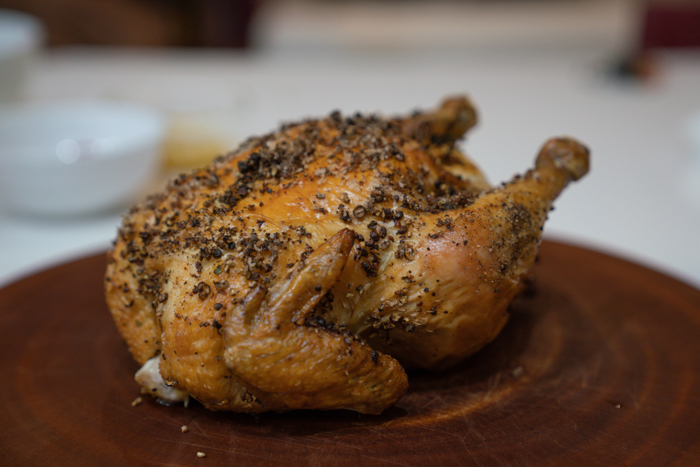
The reason why it’s so important to figure out where you want to go with cooking is that everyone learns differently and there is a huge variety of free and paid online cooking courses available. Each cooking course is designed for a specific audience. So, by doing your research and understanding yourself, you’ll get the best value for your investment (if you’re planning on paying for a cooking course).
Most importantly, Gordon Ramsay’s Masterclass is not really made for the beginner home chef. Yes, you do go over some basics when it comes to cooking certain ingredients and there are some easier recipes (such as the elevated scrambled eggs and roasted eggplant). However, the majority of the recipes that are included are probably a little too time consuming for the beginning home chef.
Overall, here are the different categories of cooking resources that you’ll run into, who they’re for and how they compare to the Gordon Ramsay Masterclass.
YouTube Cooking Channels

The huge variety of different YouTube channels created by chefs with different personalities and niches such as Binging with Babish, Kenji’s Cooking Show, Jun’s Kitchen, and Tasty.
Who’s It for: These YouTube channels are great for any home chef looking for a variety of new recipes to try at home who learn better by watching it being done.
Comparison: With the YouTube channels, you’ll have to sift through the recipes to find the tastiest ones and the recipes that fit your lifestyle the most. The biggest downside with YouTube cooking channels is that most YouTube channels don’t have their recipes available in written form which is easier to reference when cooking. Additionally, YouTube channels don’t have crowdsourced ratings for each recipe like you would find in a cooking blog.
Cooking Blogs
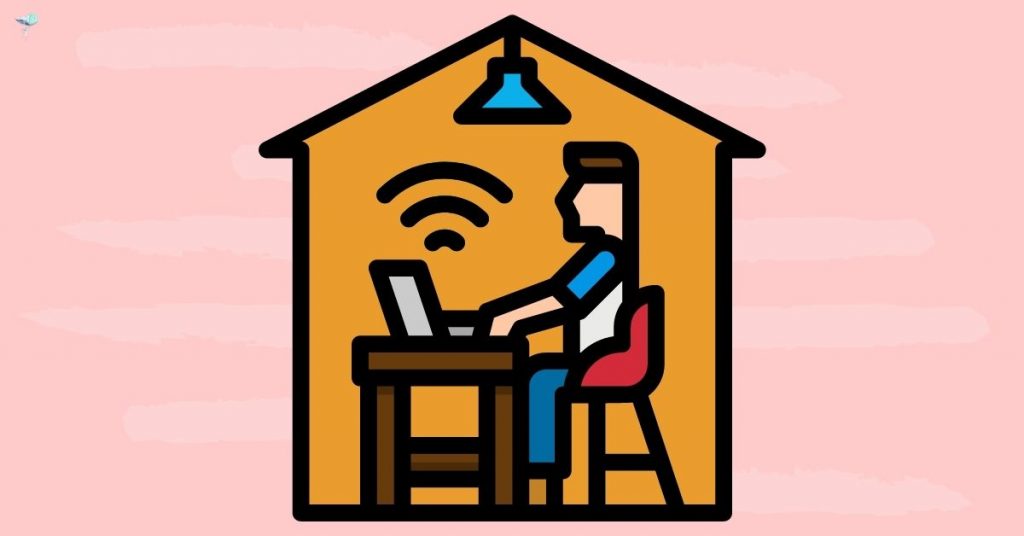
Different cooking blogs created by professionals and home chefs with different personalities and niches such as Feasting at Home, My Korean Kitchen, and Simply Recipes.
Who’s It for: Blogs are a good way for any chef to find new recipes to try at home and for those who find it easier to follow a written recipe.
Comparison: with cooking blogs, you’ll have to sift through the recipes to find the best ones and some recipes can be hit or miss. Many blogs also don’t have videos for their recipes so you’ll have to rely on the written recipe and photos to help when you’re cooking.
In-Person or Online Cooking Classes

In-person or online cooking classes led by a professional chef who teaches you how to cook usually over 2 hours.
Who’s It For: home chefs and foodies who want to take friends or families out for an experience and share their passion for cooking.
Comparison: Gordon Ramsay’s Masterclass feels intimate enough to be an in-person cooking class, however, since it’s prerecorded there is no way for you to interact with the chef or others in the class. Most in-person or online cooking classes cover easier recipes as well.
Cookbooks

Collection of incredible stories and recipes written by great chefs such as Momofuku by David Chang, Bitter Honey by Letitia Clark, and Keeping It Simple by Yasmin Fahr.
Who’s It For: Any chef who wants to dig deeper and who like to reference a collection of recipes in written form.
Comparison: Most of the time cookbooks will dive deeper into the stories and recipes of the author than other formats. However, most cookbooks don’t have videos for each recipe and they don’t have room to include images for each step in the recipe which can make it harder to follow along.
Recorded Course Created and Taught by A Master Chef
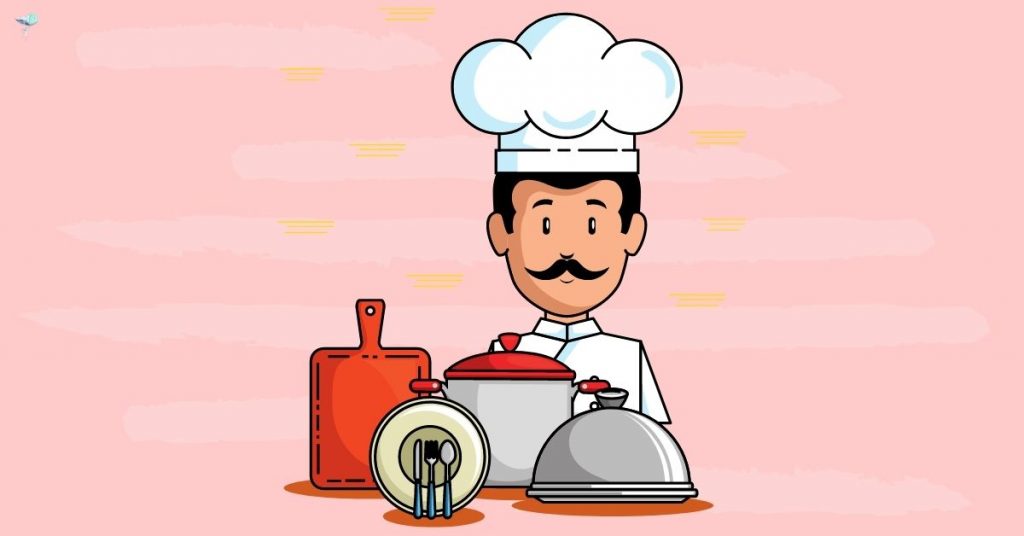
A course such as the Gordon Ramsay Masterclass in which the master creates and teaches the entire course from start to finish.
Who’s It For: chefs of all skill levels who would like to get an inside look into the mind of one of the best chefs there is. Additionally, chefs who want to learn things that you can’t find in cookbooks, cooking blogs, and YouTube channels.
Comparison: Currently there are other online cooking classes available (both live and prerecorded). However, there is no other option with as big of name power and deep selection of famous chefs as there is in the Masterclass library.
The Gordon Ramsay Masterclass

Cooking is personal, magical, and is one of the best ways to bring people together. Just one dish, one smell, can transport people to other countries or to other times in their lives (just like that flashback scene of the food critic Anton Ego in Ratatouille).
Most importantly, it’s a uniquely creative craft. Even if two chefs cooked the same recipe with the same ingredients, they’ll likely approach cooking the recipe differently and the final dish will taste slightly different.
What makes this course so unique is that it’s taught by Gordon Ramsay who is arguably one of the most famous chefs in the world. Additionally, many of the recipes featured in his 2 Masterclasses are based on dishes served in his 3 Michelin Star restaurant, Restaurant Gordon Ramsay.
The way this course is set up is a lot like a one on one cooking lesson with Gordon Ramsay. He walks you through each step of each recipe and by doing so you will learn the shortcuts and “secret knowledge” that Gordon Ramsay has accumulated over the years as a fine dining master chef.
What I like about his Masterclasses is that he is an extremely good teacher. He makes each complex recipe easy to understand and concisely explains why he does certain things which will help the dish taste better or make you more efficient while cooking.
For example, I picked up these little nuggets of information from his lessons:
- Always put oil in a hot pan. If you put oil in a cold pan, by the time it gets hot it will be burnt.
- Poaching eggs in red wine is an extra step you can take to make poached eggs even more decadent.
- Infusing lemon zest with your salt is a great way to take acidity to your dishes and take your seasoning to another level
- The key to a perfect scrambled egg is to NOT beat your eggs before you put it into the pan with butter.
- Always cook salmon skin side down.
- Before you cook the salmon, take it out of the fridge to warm up for 5-6 mins. If your salmon is ice cold, you will never cook it properly in the center.
- Score the salmon skin which will prevent it from buckling from the heat and it will stay flat in the ban.
Since there are two different Gordon Ramsay Masterclasses I’m first going to go over what you can expect from each lesson in Gordon Ramsay Teaches Cooking I. Then, instead of talking about what you’ll find in “Gordon Ramsay Teaches Cooking II”, I’m going to show you what recipes I have tried out so far at home.
- Who is this course for?
- Home chefs who are looking to impress their friends and family when they throw dinner parties.
- Going off of point #1, anyone who is looking to master a repertoire of complex, beautiful, yet feasible dishes to cook at home, especially for special occasions.
- A foodie who wants to learn how to cook from one of the best in the industry.
- Anyone who wants to learn insider tips and tricks that you don’t usually find in cookbooks, cooking blogs, or YouTube Channels.
- Any fan of Gordon Ramsay who would like to recreate variations of dishes that have made him famous.
- Anyone who also plans to take other cooking classes in the Masterclass library such as the ones from Thomas Keller, Gabriela CÁMARA, Massimo Bottura, Alice Waters, Wolfgang Puck, Aaron Franklin, and Dominique Ansel.
- Who is this course not for?
- If you’re new to cooking and are still looking to learn the fundamentals of cooking.
- If you don’t have any plans to follow through and cook some of the recipes.
- Anyone who is looking for quick and easy recipes to follow as most of the recipes in the Masterclass require many steps and take time.
- If you’re not a fan of Gordan Ramsay or any of the other chefs in the Masterclass library.
Check out the Gordon Ramsay Masterclass through the link below!
A Quick Note on Masterclass

The cost for the Masterclass Annual Pass is $180 ($15/month) and for this price, you get access to the Gordon Ramsay Masterclass and the rest of the Masterclass Library.
In my opinion, this is an incredible value considering the quality of the classes and the level of expertise of each teacher. There is honestly no other online course where you can take 2 different Masterclasses with Gordon Ramsay and then the next day take a Masterclass with Alice Waters and the following day a Masterclass with Thomas Keller or Massimo Bottura.
Since the focus of this article is on the Gordon Ramsay Masterclass, I’m not going to get into the details of the other classes. However, if you want to see what other classes are in the Masterclass library, you can just head over to their website. Once you’re there, you can browse each class offering and you can even see detailed information about each lesson in the class.
Inside the Gordon Ramsay Masterclass – A Complete Look

In the Masterclass Library, you’ll find 2 different Gordon Ramsay Masterclasses with a total of 35 different lessons spread over 8+ hours. Out of the 35 lessons, there are a total of 16 “recipe” lessons where Chef Ramsay walks you through how to create a specific dish.
As I mentioned at the beginning, I’m going to briefly cover what you’ll find in each lesson of the first Gordon Ramsay Masterclass – Gordon Ramsay Teaches Cooking I. Since the second Masterclass, Gordon Ramsay Teaches Cooking II is all recipes, I’ll then go over what recipes I have cooked so far at home in the “Cooking Journal” section of this article.
Chapter 2 – Gordon’s Journey: Learning From The Masters

In the second lesson, you get to meet Gordon Ramsay and hear all about his story and the chefs he worked for in London and Paris when he first started his chef’s journey.
Why It’s Useful: All great stories have a beginning and it’s fascinating to hear about why Gordon Ramsay started cooking and his journey to become the chef he is today.
Chapter 3 – Method: Kitchen Layout

In this lesson, Gordon Ramsay gives you a tour of his kitchen at home and shows you the pots, pans, knives, and other tools that he uses daily. He also goes over the importance of being organized in your kitchen before you start cooking.
Why It’s Useful: Most people probably don’t have as nice of a kitchen as Gordon Ramsay. However, what’s important to understand is that it’s not the size of the kitchen that’s important, its being organized and knowing your kitchen.
Chapter 4 – Mastering Ingredients: Vegetables and Herbs

In this lesson, chef Ramsay reviews how to select the tastiest vegetables and most fragrant herbs and how to use them. My favorite part is when he explains how to use certain “uglier” vegetables (like fennel, celery root, baby carrots, heirloom tomatoes, and endives) that you might not think to buy when you go shopping.
Why It’s Useful: It’s important to understand the different vegetables and herbs and how to use them. For example, I never knew how to use fennel or the fact that you shouldn’t peel baby vegetables such as baby carrots or baby radishes until taking this lesson. Additionally, the information he provides on herbs will allow you to get the most out of them.
Chapter 5 – Make: Poached Egg & Mushrooms on Brioche

This is the first cooking class in the masterclass. In this lesson, Gordon Ramsay teaches you how to make a decadent poached egg & mushrooms on Brioche. What’s nice about this recipe is that it’s simple to customize based on what you have at home.
Why It’s Useful: This dish is delicious and provides a solid foundation for creating a mouth-watering dish for breakfast or brunch. If you want to see what my version looked like, check out my at-home example in the cooking journal below.
Chapter 6 – Method: Knife Skills

Chapter 6 is all about knife skills. In this lesson, Gordon Ramsay reviews how to hold a knife, how to sharpen your knife, and the best things you can do at home to improve on your knife skills. He also shows you how to get a fine dice on weirdly shaped vegetables which is useful to know.
Why It’s Useful: Knife skills are one of the most important skills to hone in the kitchen. Having better knife skills will make cooking more fun, more efficient, and you’ll be able to get the most yield from your ingredients which will save you money.
Chapter 7 – Make: Elevated Scrambled Eggs

In this lesson, you learn how to make the perfect scrambled eggs. Gordon Ramsay elevates his scrambled eggs to a ridiculous level by adding white truffle and sea urchin. Although this step is a little unrealistic for most home chefs, it’s fun to watch.
Why It’s Useful: Scrambled eggs are much harder to make then they seem and after this lesson you will know 100% how to make the perfect scrambled eggs. If you want to see what my version looked like, check out my at-home example in the Cooking Journal below.
Chapter 8 – Method: Breaking Down a Whole Chicken

In this chapter, you learn what to look for when buying a whole chicken, how to break it down, and some suggestions of how to use each part of the chicken in recipes.
Why It’s Useful: Learning how to break down an entire chicken will save you money and will give you the flexibility to create multiple recipes from the different parts of the chicken.
Chapter 9 – Make: Chicken Suprême with Root Vegetables

In this lesson, you learn how to make a simple and mouth-watering chicken breast recipe that is anything but boring.
Why It’s Useful: Even if you don’t follow this recipe step by step, the techniques you learn in this lesson will give you the knowledge to cook the juiciest most delicious chicken breast dishes.
Chapter 10 – Mastering Ingredients: Fish & Shellfish
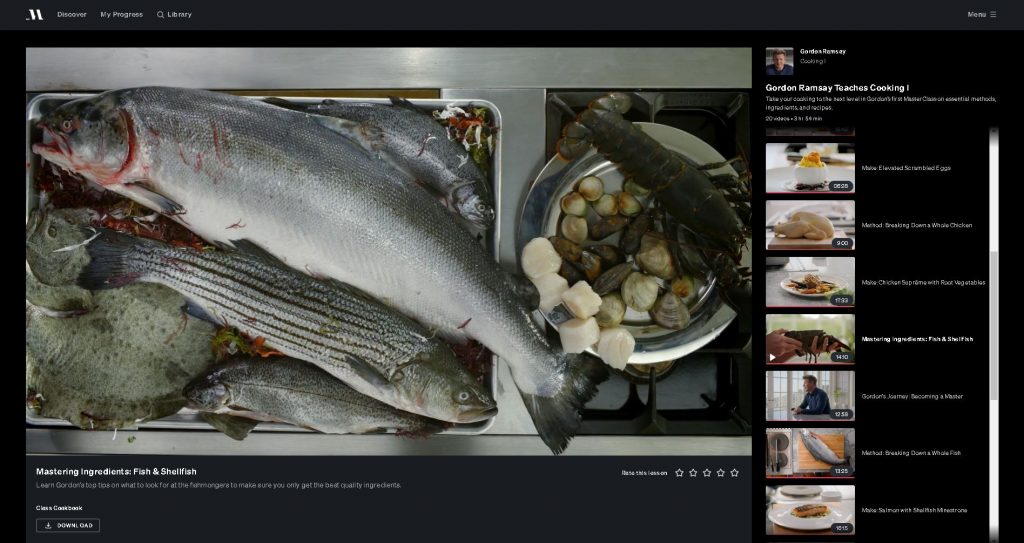
In this lesson, Gordon Ramsay reviews everything he looks for when picking out fish and shellfish ingredients. For example, when buying a fish, make sure its gills are red and its eyes are not sunken and when choosing a lobster, pick it up and make sure it’s firm and weighty. He also shows you how to properly store scallops in the fridge to keep their shape.
Why It’s Useful: Fish and shellfish are some of the most expensive and most delicious ingredients so it’s important to understand how to pick them and how to store them so you don’t damage the ingredients.
Chapter 11 – Mastering Ingredients: Gordon’s Journey: Becoming a Master

Continuing from Chapter 2, in this lesson Gordon dives deeper into his chef’s journey and you hear about how he started his first restaurant and his journey to earning 3 Michelin Stars.
Why It’s Useful: Even though Gordon Ramsay is a world-renowned chef now, that wasn’t always the case. For example, when he first started he could not afford the most expensive ingredients at his restaurants and had to make delicious dishes from what he had. This is a lesson that all of us should take into our home kitchens too!
Chapter 12 – Method: Breaking Down a Whole Fish

This chapter provides a step-by-step tutorial on how to fillet a whole salmon.
Why It’s Useful: Similar to Chapter 8, you will save money if you can buy salmon whole and break it down yourself.
Chapter 13 – Make: Salmon with Shellfish Minestrone

In this lesson, you will learn how to make an elegant Salmon with Shellfish Minestrone. Most importantly, you will learn tips and tricks on how to perfectly cook a skin-on salmon fillet.
Why It’s Useful: It’s so easy to mess up a beautiful salmon fillet and in this lesson, you gain practical tips and knowledge on how to perfectly cook the salmon fillet every time.
Chapter 14 – Method: Making Pasta Dough

In Chapter 14, Gordon Ramsay shares the secret tips and tricks of making pasta dough from scratch that he learned from his time in Italy.
Why It’s Useful: Pasta dough is the foundation of many Italian dishes and by making your pasta dough from scratch it will allow you to elevate your homemade pasta-based dishes to another level.
Chapter 15 – Method: Rolling Pasta Dough
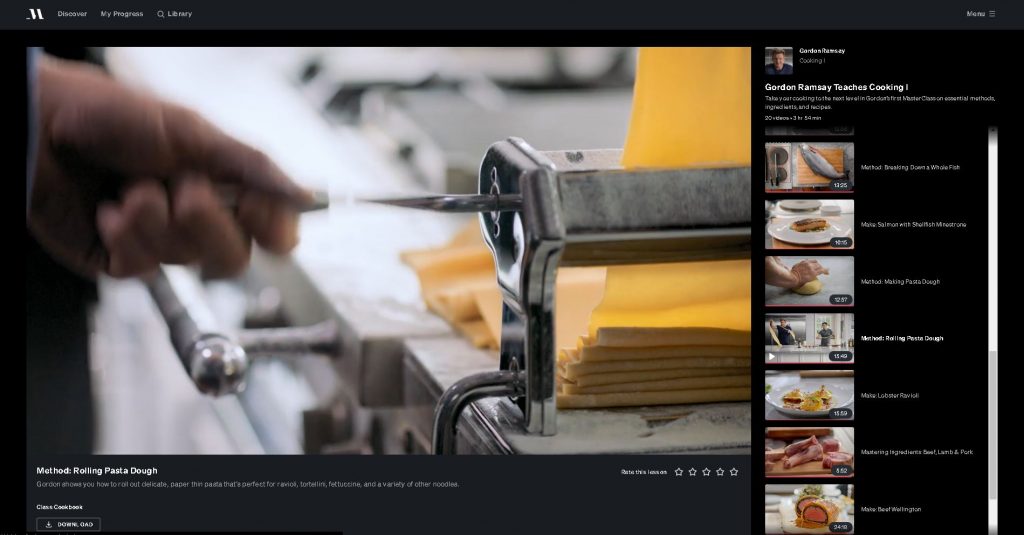
In this lesson, Gordon Ramsay shows you how he rolls out paper-thin pasta that could be used for ravioli, tortellini, fettuccine, and a variety of other pasta dishes. In this case, Gordon is rolling out the pasta to make his lobster ravioli which is Chapter 16.
Why It’s Useful: Even if you don’t plan to roll out your pasta anytime soon, it’s nice to get an idea of how to do it just in case you do.
Chapter 16 – Make: Lobster Ravioli

In this chapter, he teaches you how to make the Lobster Ravioli which he serves at his 3 Michelin Star Restaurant Gordon Ramsay.
Why It’s Useful: It’s cool that Gordon Ramsay shares this recipe with us as its the only dish which has remained on Restaurant Gordon Ramsay’s menu since it opened. Most importantly, even if you don’t plan on making a ravioli with lobster, the techniques you learn can be applied to any type of ravioli or even variation of a dumpling.
Chapter 17: Mastering Ingredients: Beef, Lamb & Pork

In chapter 17, Gordon gives you a quick overview of the different cuts of beef, lamb, and pork. Most importantly, you learn that Gordon Ramsay prefers to use cheaper cuts of meat as those are the cuts of meat that he grew up with.
Why It’s Useful: Gordon provides a nice reminder that you don’t need the most expensive cuts of meat to make delicious dishes.
Chapter 18: Make: Beef Wellington

In Chapter 18 Gordon teaches you how to make his iconic Beef Wellington. Most importantly he gives you tips and tricks and demonstrates that it’s not as hard to cook as it may initially look.
Why It’s Useful: Gordon Ramsay’s Beef Wellington is the ultimate WOW dish for any special occasion or dinner party so it’s nice to have it in your repertoire of recipes for when you need it.
Chapter 19 and 20: Advice for Life and Closing

In the last 2 short lessons, Gordon talks through some of his closing advice and thoughts based on his own experiences. Most importantly he urges you to find your passion as “everything else falls into place once you’ve got that track set to climb the ladder”.
Why It’s Useful: As an entrepreneur myself, his advice resonated with me as passion is the #1 reason how we have gotten through the ups and downs of building Wit and Folly into what it is today.
Cooking Journal – The Recipes I Have Tried and What I Think
I have been slowly working my way through the recipes in Gordon Ramsay’s Masterclasses and so far I have been impressed. Some of the steps in his recipes such as adding sea urchin and white truffle to his scrambled eggs are a little unrealistic for me. However, overall the recipes have been easy to follow and have allowed me to create memorable dishes that I didn’t know how to cook before.
I have cooked 6 of his recipes so far, but plan to make my way through all 16 recipes so make sure to come back to this post and follow along!
Here are the recipes I have cooked so far.
Recipe #1 – Poached Egg and Mushroom on Brioche


Why I like This Recipe: It was simple to make yet delicious and decadent at the same time. I could easily see myself making this for breakfast even on a busy weekday. Additionally, the poached eggs and sauteed mushrooms in this recipe give you a solid foundation in understanding different ways of preparing eggs and sauteeing mushrooms that you could easily use in other recipes. I have already used the same sauteed mushrooms on omelets and by itself as a side dish.
What I Didn’t Like: For what it is, there is nothing I didn’t like about this recipe
Cooking Notes:
- Poaching the eggs is much easier than I thought it would be. Make sure to dry off the eggs after taking them out (as mentioned in the recipe) or else you will soak your bread and mushrooms with water.
- Make sure to use good brioche bread. When I cooked this dish the second time, I bought a cheaper brioche bread and the dish wasn’t as good.
Recipe #2 – Elevated Scrambled Eggs
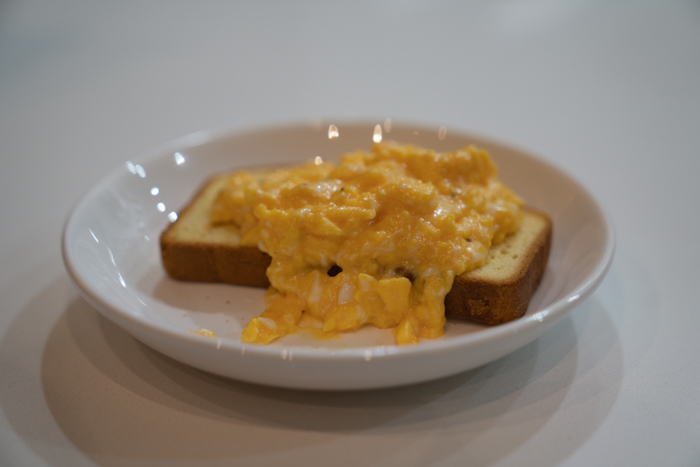
Why I like This Recipe: Most importantly Chef Ramsay clearly shows you how to cook scrambled eggs right. I didn’t know before taking this lesson that the best way to cook scrambled eggs is to cook unbeaten eggs with butter at the same time. I had always thought you’re supposed to whisk the eggs before cooking.
What I Didn’t Like: As I mentioned already, some parts of this recipe such as adding sea urchin and white truffle weren’t realistic for me and I’m guessing it’s not realistic for other home cooks too. With that said, even without the white truffle and sea urchin, the recipe makes a delicious scrambled egg.
Cooking Notes:
- The more butter the better.
- Don’t forget to season your eggs after cooking.
- The scrambled eggs also make a great sandwich if you pair it with turkey or ham on toasted bread.
Recipe #3 – Roasted Eggplant with Basil and Feta

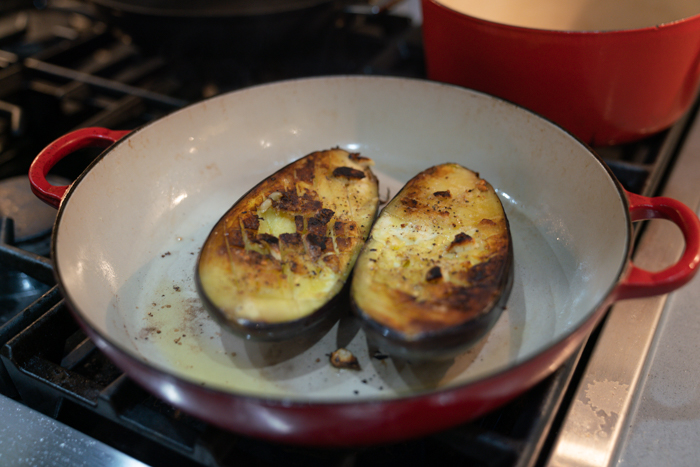

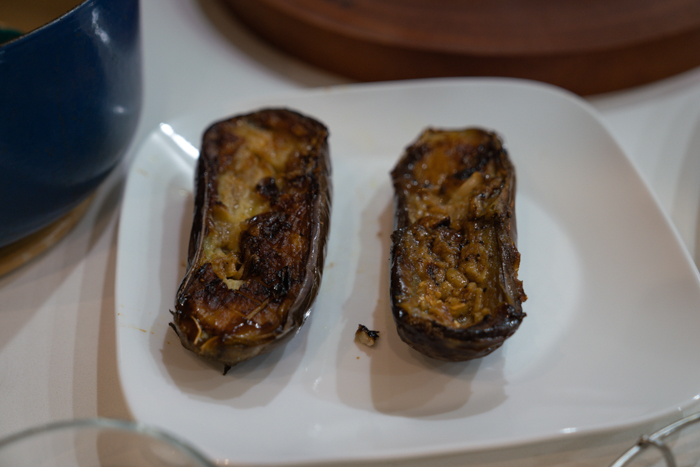
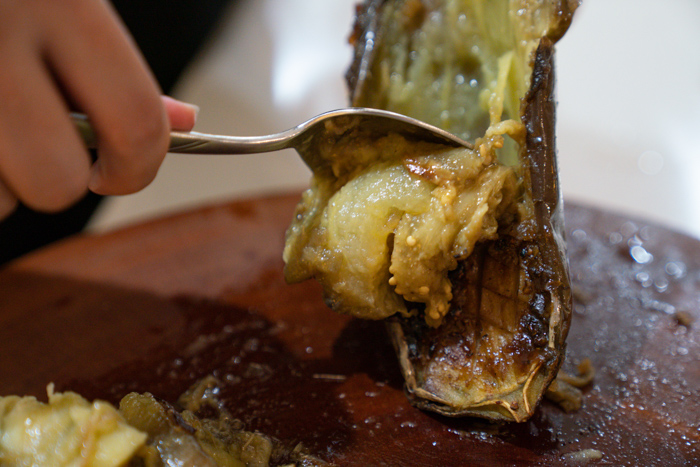
Why I Like This Recipe: I like this recipe because it gives you a solid technique on how to roast eggplant and get rid of its bitterness. The roasted eggplant part of this recipe is decadent and creamy and makes a great side dish or main course.
What I Didn’t Like: In the second part of the recipe it calls for scooping out the roasted eggplant and mixing it with onions, seasoning, and tomatoes. In my opinion, this took the recipe too far as the flavor of the tomatoes overpowered the more subtle flavors of the eggplant.
Cooking Notes:
- Even though the final dish was not the best by itself, it makes for a great pasta sauce or the tomato base for Shakshuka.
Recipe #4 – Szechuan Roasted Whole Chicken


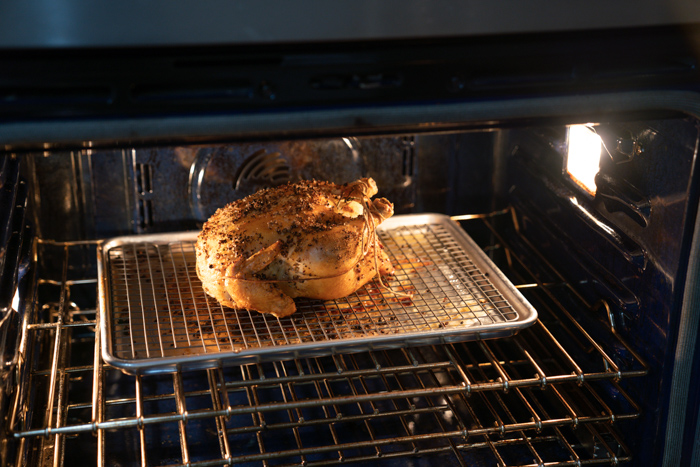

Why I Liked This Recipe: This is a restaurant-quality way to roast chicken and to use every part of the chicken. The prep time is minimal, the seasoning is on point and it creates a fragrant, juicy chicken that tastes like it has been slow-cooked for hours. The chicken is already great as is, but I decided to take the additional step of making two additional recipes from the chicken, Gordon Ramsay’s Hoisin Chicken Salad and Szechuan Chicken Breast and Udon Noodles. I also used the chicken carcass to make a flavorful chicken broth for the udon noodles.
What I Didn’t Like: Nothing. This has been my favorite set of recipes from the Masterclass so far and is a great way to impress family and friends.
Cooking Notes:
- Make sure to rest the chicken for at least 10 minutes after cooking as the recipe notes.
- At the same time, don’t wait too long after the 10 minutes as it’s easier to carve the chicken when it’s still warm.
- It’s worth the effort to make some lemon salt.
- Take your time when carving the chicken. Even after watching the steps multiple times, I still messed up.
Recipe #5 – Hoisin Chicken and Pickled Daikon Salad

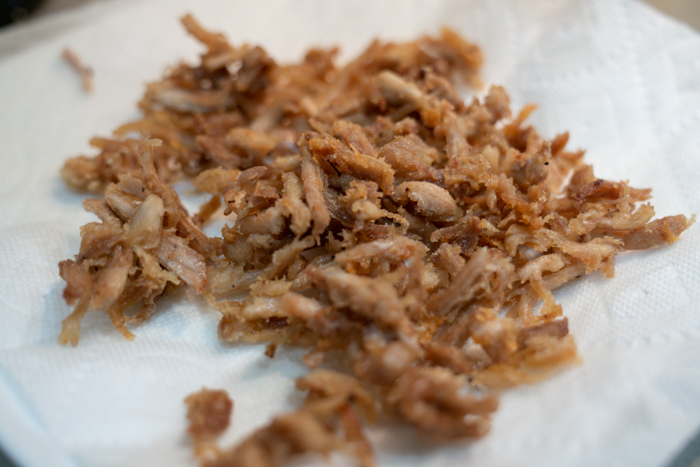
Why I Liked This Recipe: I can honestly say this was the best salad I’ve ever had. What I like most about this recipe is its flavor combination of salt from the chicken, acidity from the dressing, and crunch from the lettuce. Here is a quote straight from one of my family members after he tasted this salad for the first time that sums this dish up nicely “Dang that’s good! I don’t think I’ve ever tasted this flavor before and I’ve been to some fancy restaurants!”.
What I Didn’t Like: The only downside of this dish is that it takes much longer to prepare than the traditional salad.
Cooking Notes:
- Even though you can use regular lettuce, splurging for butter lettuce is worth it.
- To save time, you can skip the pickled daikon and ginger. I didn’t use these two ingredients and the salad was still amazing.
- To save more time, you can shred the chicken beforehand. Just make sure to fry the chicken just before serving.
- The salad dressing recipe is extremely easy and tasty and could be easily used for other salads too.
Recipe #6 – Szechuan Chicken Breast and Udon Noodles
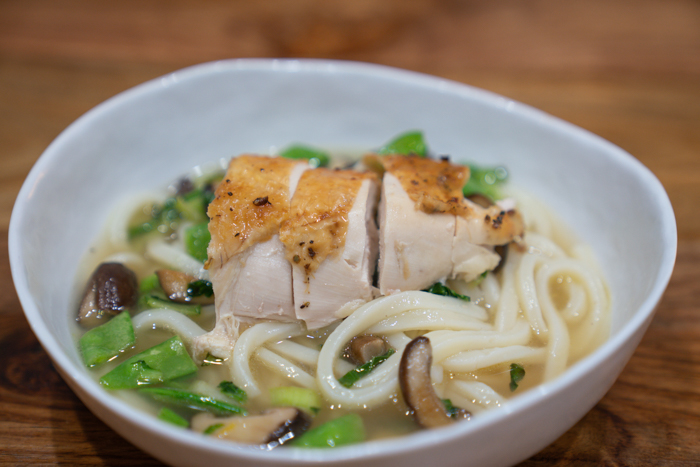

Why I liked This Recipe: This is a great way to stretch the chicken further and to get as much yield as possible. Overall, it’s a show-stopping savory recipe that is perfect for colder days. Here are a few things I like about this recipe:
- The recipe gives you the foundation for a luscious chicken broth that could be used for many other dishes. Plus, it’s a great way to use every part of the chicken.
- It teaches you how to respect the chicken breast and to keep them juicy. At the same time, you learn how to reheat chicken breasts if you need to prepare the chicken in advance.
- Restaurant quality udon soup that would probably cost $15-$20 at a restaurant.
What I didn’t Like: It’s easy to make this dish too salty because of all the salt used in seasoning the chicken. Before adding salt to the dish or soy sauce (which is one of the steps), make sure to taste test to see if you need the additional salt.
Conclusion
Cooking is extremely personal and there are so many different ways that you can improve. Like many creative skills, one of the best ways to improve is by doing it.
This Masterclass is a great combination of practical advice and tips that you normally don’t find from cooking blogs, cookbooks, or YouTube channels. It also gives you step by step instructions from the master chef himself on how to make iconic, showstopping dishes at home that will no doubt impress your family and friends.
Yes, you could easily find delicious recipes from different sources online, but if you truly want to elevate your cooking, this is a good investment.
Plus, if you’re passionate about cooking, you’ll also get access to Masterclasses from Thomas Keller, Gabriela Camara, Massimo Bottura, Alice Waters, Wolfgang Puck, Aaron Franklin, and Dominique Ansel too!

